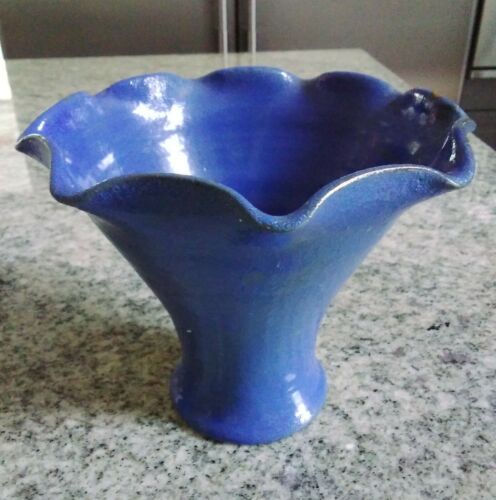-40%
Rare Antique Bybee Blue Pottery Fluted Vase Hand Thrown KY Clay Marked 94
$ 68.11
- Description
- Size Guide
Description
Authentic, genuine, original, an exceptional example of Bybee Pottery, this sweet fluted vase with its fluid, flowing lines is a rare offering. Note the hand-thrown finish and the hand-formed fluted edges. It was once in the possession of the seller's ninety+ year old aunt and neighbor in Kentucky, made a gift more than 60 years ago. It is marked '94 - a pattern number, according to a researcher who estimates that the piece was made in the early 20s. Still in remarkably good condition, it is a rare treasure waiting for a home where it will be cherished as a glimpse into the past and a tribute to the Old Kentucky Home. 6.5" wide, 5.75" tall.Beautifully preserved despite its age! One tiny place where the paint did not cover. Three tiny chips under the fluted edges, the largest less than 1/4 inch - see photos. Carefully stored and displayed.
It will be very carefully packed and shipped with the reverence and respect it deserves.
The oldest existing pottery west of the Alleghenies, Bybee Pottery was located in the small rural town of Bybee, among the southern hills of Madison County, Kentucky. The old log building has housed the equipment and business of the Bybee Pottery for over a century. It stands as a landmark of pioneered days. Legend states that this pottery was originally established in 1809, and actual sales records prove its existence as a thriving industry as early as 1845.
The process of mining the clay, grinding it in the antique pug mill, throwing and shaping it by hand into articles of ornamental and practical use on the potter's wheel, is very much the same today as it was over a century ago.
The clay used by the pottery is found in ample deposits approximately three miles from Bybee. This clay is open-pit mined several feet beneath rich Kentucky topsoil. History records that this same clay was mined by the first settlers of Kentucky, then taken to Fort Boonesborough to be used for making crude dishes.
The clay, mixed with water, is ground in the old pug mill and stored in an ancient vault where it is kept moist and pliable. It is weighed on old balances to secure uniformity, and then thrown by the potter and shaped into the desired form. Each piece is allowed to dry completely, then it is glazed and fired in a kiln heated to 2200 degrees. Emerging from the kiln, the clay, now a finished piece of pottery, is ready for sale.
Walter Cornelison, successor to Webster, James Eli, Walter and Earnest Cornelison, is the fifth generation Cornelison to own and operate Bybee Pottery


















